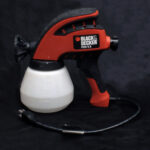Ragging is a broken color technique which creates a random pattern that echoes crushed velvet. This quick and easy paint effect is ideal for walls or fitted furniture such as a run of cupboards.
It is easy to get a pleasing result with ragging, a quick paint technique which uses rags to make patterns in thinned paint. The random pattern is perfect for adding interest to a large expanse of wall and is useful for disguising uneven or blemished surfaces. You can also use it when you want an interesting finish on smaller areas such as kitchen units, skirting boards and shelves.
Ragging requires very little equipment. All you need is two colors of a paint suitable for the surface, a roller, a paint brush and plenty of clean rags. Emulsion is usually the best choice of paint for a large area such as a wall. The technique can be used to produce a wide range of effects depending on the colors you choose, the sort of rag you use and how tightly you gather it up.
There are three methods of ragging, ragging off, ragging on and rag rolling. Whichever method you choose, one or two coats of a base color must be applied first and allowed to dry. When ragging, the pattern is affected by the way the rag is scrunched. The tighter the rag, the more dense the pattern will be. It is important to keep to the same degree of scrunching over a whole wall to avoid a patchy effect.
Ragging off is the most commonly used method. After allowing the base coat to dry, paint on a coat of thinned emulsion in a second color. Scrunch up a rag and press it on to the wet painted surface to make a random pattern by removing some of the thinned pain to reveal patches of the base color.
Ragging on, produces a more pronounced pattern than ragging off. Once the base coat is dry simply scrunch up a dry rag and use it to apply the thinned emulsion in your second color.
Rag rolling produces a more regular pattern than other methods. It should be done in vertical lines to produce an even effect. The thinned emulsion is first applied over the dried base coat as for ragging off. Then the rag is bunched into a sausage shape and lightly rolled up the wall in one movement to form a mottle strip. This rolling is repeated over the wall.
When planning your color scheme, bear in mind that the best results are usually created by using a light shade for the base color and ragging or rag rolling a darker shade over the top. Before you begin to pain a wall, buy some tester pots of paint and experiment with different colors on a sheet of lining paper. Stick the lining paper up on the wall with masking tape to check the result in natural and artificial light.
The safest way to achieve a successful result is to combine two tones of one color, try peach ragged over pale apricot for a warm look or use a strong blue over a paler blue for a cooler effect. Avoid colors which are very close in tone or next to each other on the shade card, as these may be too similar for the effect to show up.
Be experimenting with color combinations you can create different effects. Pale grey or blue looks good over white for a pastel color scheme; apricot over cream will have more of a cozy feel. Lime green over lemon yellow will produce a vibrant scheme. To create really dramatic effects choose strong colors such as wine or a fresh green over white or ivory.
Unglazed cotton is the traditional material for ragging, and old cotton sheets are perfect. For a softer effect you could also try cheesecloth, or a role of decorator’s cloth. Synthetic fabrics such as polyester are not suitable because they don’t absorb the paint. Fabrics with a small amount of synthetic fibers such as a cotton/polyester blend would still work, but with less definition than pure cotton.
Experiment with different fabrics scrunched up tightly or held more loosely until you get the effect you want. Make sure you have a plentiful supply of cloths as the rags soon become clogged with paint. An ideal size is about 8 x 12 inches (20 x 30cm). Cut the cloth up into usable sizes before you start ragging. You must work quickly, particularly with the ragging off technique.
Before painting, first carefully prepare the walls by filling any cracks and holes and sanding rough areas where necessary. The following instructions are for ragging off, but you can experiment with the variations of ragging on or rag rolling.
With ragging, the paint needs to be worked before it dries. If you are working by yourself, it is best to apply the thinned paint to one section of the wall at a time, then rag over it before moving on the next section. If you can get a friend to help, one person can work ahead, applying the thinned paint and the other can follow behind with the rag, removing some of the wet paint.
Gather all your equipment first. You will need:
Rubber gloves
Emulsion paint in two colors
Paint roller and tray
Paint kettle
3inch (8cm) paint brush
Clean rags
Ragging a wall
1. Applying the base coat: Using a roller, apply a coat of the base color. When this is dry, if necessary, paint on a second coat. Allow to dry thoroughly before starting the ragging process.
2. Applying the top coat: In a pain kettle, gradually add water to emulsion paint in your second color until the paint is thinner than the consistency of single cream. Brush the thinned paint over the base coat, working quickly over one section of the wall at a time.
3. Ragging off: Scrunch up a rag and dab it lightly and quickly on the wall, removing some of the thinned paint. Vary the direction of your hand and adjust the rag occasionally for a random pattern.
4. Checking the effect. Continue working over the wall, one section at a time. Stand back from the wall at intervals to check the result, and lightly touch in any missed areas. When the rag becomes clogged with paint, use a fresh rag or rinse it with water and squeeze out the excess before continuing.
Ragging cupboard doors
Before you start on a large expanse of wall, you may prefer to experiment with a smaller ragging project such as wooden cupboard doors or kitchen units. The technique is just as successful over wood as over walls. The method is the same except that a tougher water-based or solvent-based satin finish paint is used instead of emulsion.
Ragging looks effective when used together with another paint technique. For example, recessed cupboard door and drawer panels can be ragged while the rest of the unit can be given a different finish, like slowly and firmly dragging a paint brush over the surface in one direction so the brush strokes are clearly visible.
All cupboards and units should be well cleaned before painting. Remove door and drawers knobs, then wash down doors and frames with hot soapy water. When dry, wipe over with methylated spirit.
1. Painting the base: Apply a coat of primer on new or bare wood. When dry, paint on a coat of satin finish paint in the base color. Allow to dry. Mask off the area around the panels.
2. Applying the paint: Thin pain in the second color with water or white spirit, depending on if it is water- or solvent-based, so it is a bit thinner than single cream. Use a paint brush to apply an even coat to one panel.
3. Ragging the surface: Scrunch up a clean dry cloth to the required tightness and dab it on to the thinned wet paint to leave a ragged pattern.
4. Picking out the molding: Wrap you index finger in a clean piece of cloth and run it carefully around the molded part of the door, to remove any thinned paint. Apply paint and rag off other panels in the same way. Leave to dry.
5. Painting panel surround: (optional): Remove all masking tape. Apply a coat of thinned paint to areas around the panel and then draw a clean, dry brush slowly and firmly over the surface in one direction, leaving brush marks. Let paint dry.



